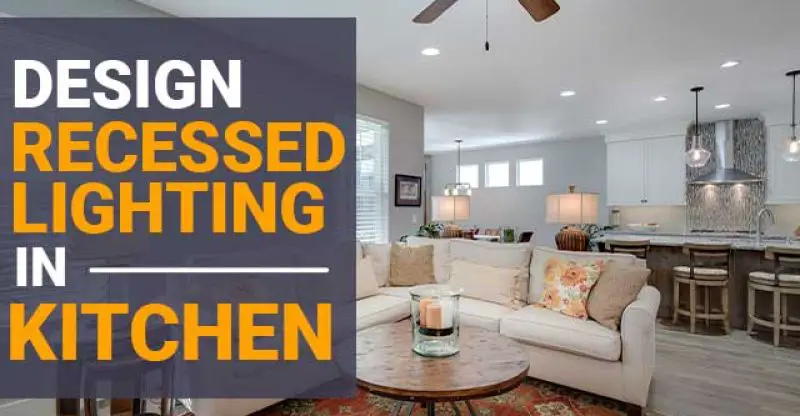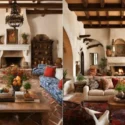How to Design Recessed Lighting in a Kitchen?
Recessed lighting can make all the difference in the world when it comes to making your kitchen look stylish, functional, and beautiful. While recessed lighting can be expensive to install, it pays off big time in terms of efficiency and aesthetics.
Recessed lights illuminate the area around the counter so that the shadows of the people working near the counter are not created. Recessed lighting was used for a long time, but they were famous for some years. They are also called Downlights. They fixed it inside the ceiling. Our kitchens need proper lighting so that all the day’s activities are done in the best possible way.
This type of lighting will not only allow you to cook and prepare food more easily, but it will also make your kitchen look more beautiful overall. The right design of recessed lighting can draw people’s attention to certain parts of your kitchen or highlight your kitchen’s features, such as its cabinetry or appliances.
What is Recessed Lighting & its Different Types
Recessed lighting is an electric light fixture that is typically mounted into the ceiling, usually within an electrical box. These fixtures are unobtrusive and concealed by the drywall or plaster around them so they don’t interfere with the ceiling’s aesthetic appeal.
The fixtures themselves can either be surface-mounted, where they are set flush with the ceiling, or inset, where they protrude from it for better illumination.
There are three types of recessed lights: spotlights, accent lights, and general-purpose lights.
- Spotlights are best for highlighting specific areas of interest such as artwork or a fireplace mantel.
- Accent lights are typically installed along the perimeter of the ceiling and cast light on walls, furniture, or other objects within the room.
- General-purpose lights can be used just about anywhere they’re needed. With this many options, you should choose the type that suits your needs best.
How Many Parts Are There in Recessed Lights?
Any recessed light has three parts:
- Bulb
- Casing
- Trim
Casing refers to the cover that surrounds it and has many styles. The bulbs used in it are also found in many types when you intend lights in the kitchen. a trim piece that attaches around the edge of the fixture to hide wiring and other mounting hardware. Trims come in different sizes and colors depending on the type of recessed light you’re using.
3 Ways to Design Recessed Lighting in a Kitchen
Whether you’re remodeling or building from scratch, take some time to consider these three ways to design recessed lighting in a kitchen.
- Create Drama: You can put recessed lighting anywhere. However, they are especially well-suited for creating drama in spaces with high ceilings or other architectural features. If your kitchen has one of these features, consider adding recessed lighting, it will make your area even more awe-inspiring.
- Light Up the Ceiling: Avoid hanging lights directly above your workspace (the kitchen table, for example). Instead, set your lights lower to provide indirect light that bounces off overhead surfaces. Try placing pendant lights over cabinets or positioning sconces on either side of a doorway. Whatever you do, don’t place pendants directly over your workspace; they’ll cast shadows on your face and make it harder to read recipes.
- Incorporate LED Lighting Throughout: There are several advantages of using LED lighting instead of conventional light bulbs. First, LEDs consume less energy and therefore save money on electricity bills. Second, LEDs create more lumens per watt than traditional bulbs and can improve lighting efficiency.
The Ideal Spacing for Recessed Lights in Your Kitchen?
There is no exact distance to the lights. The first thing is the size of your kitchen, whether it is big or small. There is light, and it is up to you how much you want to install.
There will be plenty of work in the kitchen. You can also consult an electrician to determine the distance of the lights on the ceiling. How many square feet can the place of the?
In any case, you will decide how much light you need in the kitchen, especially at night, and how much light you want. Depending on the light, your kitchen is about three feet from the wall so that there is no shadow, and the light comes down smoothly.
Choosing the Right Tools for the Job
When it comes to designing recessed lighting in your kitchen, having the right tools can make all the difference. Here are a few essential tools that will help you get the job done efficiently and effectively.
Tape Measure
This is an absolute must-have tool for any DIY project, including recessed lighting installation. You’ll need to accurately measure the dimensions of your kitchen and the placement of your lights to ensure a precise fit.
Wire Strippers
To connect the wiring for your recessed ceiling lights, you’ll need wire strippers to remove the insulation from the ends of the wires. This will allow for a secure and proper connection.
Screwdriver or Power Drill
Depending on the type of housing you choose for your recessed lights, you may need either a screwdriver or power drill to secure them into the ceiling. Make sure to have the appropriate tools on hand to save yourself time and frustration.
Voltage Tester
Before you start working with any electrical components, it’s crucial to ensure the power is turned off. A voltage tester will help you determine if there is any electrical current running through the wires, keeping you safe during the installation process.
Ladder or Step Stool
Depending on the height of your ceilings, you may need a ladder or step stool to reach the installation area. Safety is key, so make sure you have a stable and secure surface to stand on while working.
Ideal Placement for Your Recessed Lights
When it comes to designing the ideal placement for your recessed lights in your kitchen, there are a few key factors to consider. First, think about the purpose of the lighting. Are you looking to provide general illumination for the entire space, or do you need focused task lighting for specific areas, such as above your countertops or kitchen island? This will help you determine the number and placement of your recessed ceiling lights.
Next, consider the size and layout of your kitchen. Larger kitchens may benefit from more lights to ensure even illumination, while smaller kitchens may only need a few strategically placed lights. Take into account any obstacles, such as cabinets or beams, that could affect the placement of your lights.
Another important consideration is the height of your ceiling. Recessed lights can create a beautiful and seamless look, but you want to make sure they are not too high or too low. Generally, lights should be placed between 12 to 18 inches away from the walls, and spaced evenly throughout the space.
Additionally, think about the overall design aesthetic of your kitchen. Do you prefer a clean and minimalistic look, or are you going for a more dramatic and statement-making effect? The style and finish of the trim can greatly impact the overall appearance of your lights, so choose one that complements your kitchen’s style.
Creative Ideas and Inspiration for Recessed Lighting Designs
Looking for some creative ideas and inspiration to design your recessed lighting in the kitchen? We’ve got you covered. Here are some exciting ideas to spark your creativity:
Highlight Your Kitchen Island
Install recessed lights above your kitchen island to create a focal point and enhance its beauty. This will not only provide task lighting for food preparation but also give your kitchen a modern and stylish look.
Accentuate Your Backsplash
Use recessed lights to highlight your backsplash and make it a stunning focal point. Choose lights with adjustable trims to direct the light precisely where you want it, illuminating the intricate details of your backsplash.
Illuminate Your Shelves
If you have open shelves in your kitchen, consider installing recessed lights underneath them. This will not only provide functional lighting for your storage but also create a warm and inviting atmosphere.
Create a Statement Ceiling
Think beyond the traditional placement of recessed lights and install them in a unique pattern on your ceiling. This can add a touch of drama and sophistication to your kitchen, making it a standout space.
Embrace Color-Changing Lights
For a playful and vibrant ambiance, opt for color-changing LED recessed lights. These lights allow you to switch between different colors and create a dynamic and fun atmosphere in your kitchen.
What Do You Need to Plan for Recessed Kitchen Lights?
Good lighting in the kitchen has a good effect on the mood. Light fixtures are placed smoothly on the bottom so that the lights are evenly low. Make sure that the spacing between the lights is very reasonable and that lights are installed at a distance, the kitchen will be much brighter. Tops were cooking and cutting. Recessed lights above them, placed at an of a few inches.
The benefits of recessed lighting
- Recessed lights are an excellent way to add light to any room, and they can be installed in kitchens for additional illumination.
- They’re easy to install and don’t require much effort on the homeowner’s part, either. When you install recessed lights, you can choose from a variety of different types of bulbs, so you’ll never have any trouble finding the perfect one for your needs.
- The best way to illuminate different corners kitchen is through recessed lights as they are evenly mounted on the ceiling and provide uniform light.
- If you want open spaces in small kitchens, you can find them only with recessed lights.
- You can easily install recessed lights above your kitchen, cupboards, and counters, which can show the best performance by hiding in a hole. It can help to highlight the counters.
Conclusion
Recessed lights can be a great addition to any home or office space. They offer an attractive, sleek look with the ability to set a mood and improve visibility. The installation process is relatively straightforward, but there are many different parts that go into making recessed lights.
If you’re looking for something that’s cost-effective and easy to install yourself, then recessed lights might be the right choice for you. You don’t need to spend thousands of dollars to get recessed lighting in your home; with these tips on how to design recessed lighting in a kitchen, you can get the look you want at an affordable price.
FAQs
The number of recess lights you need for your kitchen depends on the size of the room. For instance, if you have a large or open kitchen with high ceilings, you’ll likely want at least eight to 10 recessed lights. However, if your space is more confined or has lower ceilings, you can get away with six to eight.
When arranging recessed lights, it’s best to have them evenly spaced across the room. You can install them under cabinets, above countertops, or along the perimeter of the room. The key is to ensure that they are centered over what you want lighting up.
Recessed lights are typically designed for the following wattage: 40 watts – 600 square feet, 60 watts – 800 square feet, 75 watts – 1000 square feet, and 100 watts – 1200 square feet.
The most common sizes are 4×4 and 6×6, but these can vary depending on what type of fixture you’re using, so be sure to pay attention when measuring the area.
Roof height can affect the number of lumens you need. Higher ceilings require brighter light, and lower ceilings require less light, such as an 8-foot-tall roof. The same can be of a five-watt bulb on ten-foot-high ceilings.



